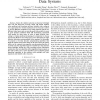Free Online Productivity Tools
i2Speak
i2Symbol
i2OCR
iTex2Img
iWeb2Print
iWeb2Shot
i2Type
iPdf2Split
iPdf2Merge
i2Bopomofo
i2Arabic
i2Style
i2Image
i2PDF
iLatex2Rtf
Sci2ools
164
Voted
ICNP
2009
IEEE
2009
IEEE
Scalable Video Multicast in Multi-carrier Wireless Data Systems
—Future 4G cellular networks are featured with high data rate and improved coverage, which will enable realtime video multicast and broadcast services. Scalable video coding is very appropriate for wireless multicast service because it allows to choose different modulation and coding schemes (MCSs) for different video layers and can provide good video quality to users in good channel conditions while still maintaining reasonable video quality for other users. In order to apply scalable video coding to wireless multicast streaming, it is important to choose appropriate MCS for each video layer and to determine the right resource allocation among multiple video sessions. In this paper we propose a two-step dynamic programming algorithm that finds the optimal total system utility of all users where the system utility can be a generic non-negative, non-decreasing function of received rate. Our algorithm supports variable layer size and thus allows flexibility during the video encoding ...
Related Content
| Added | 23 May 2010 |
| Updated | 23 May 2010 |
| Type | Conference |
| Year | 2009 |
| Where | ICNP |
| Authors | Peilong Li, Honghai Zhang, Baohua Zhao, Sampath Rangarajan |
Comments (0)

